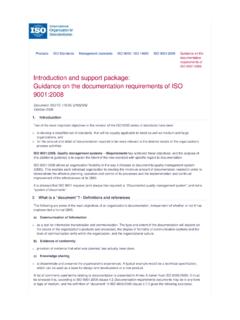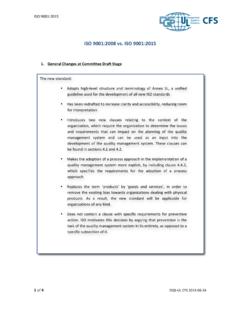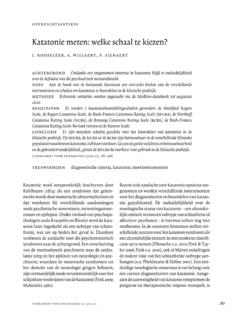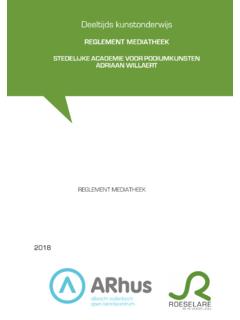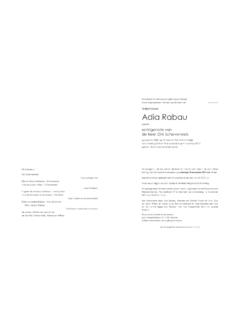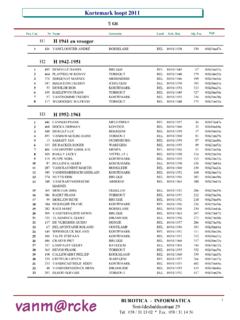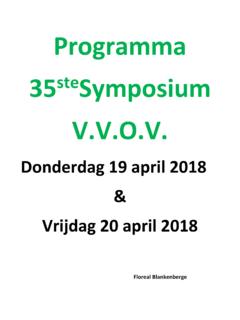Transcription of ISO 14001:2004 vs. ISO 14001:2015 - --- …
1 ISO 14001:2015 1 of 7 ISO 14001:2004 vs. ISO 14001:2015 1. General Changes at the second Committee Draft Stage The new standard: Adopts high-level structure and terminology of Annex SL, a unified guideline used for the development of all new ISO standards Has been redrafted to increase clarity and accessibility, reducing room for interpretation Introduces two new clauses relating to the context of the organization, which require the organization to determine the issues and requirements that can impact on the planning of the quality management system and can be used as an input into the development of the quality management system. These clauses can be found in sections and Makes the adoption of a process approach in the implementation of a quality management system more explicit, by including clause , which specifies the requirements for the adoption of a process approach Replaces the term products by goods and services , in order to remove the existing bias towards organizations dealing with physical products.
2 As a result, the new standard will be applicable for organizations of any kind. Does not contain a clause with specific requirements for preventive action. ISO motivates this decision by arguing that prevention is the task of the quality management system in its entirety, as opposed to a specific subsection of it. ISO 14001:2015 2 of 7 2. Structural changes Note: The new clauses in Section 4 require the organization to determine the issues and requirements that can impact on the planning of the quality management system and can be used as an input into the development of the quality system. 2004 2015 0. Introduction 0. Introduction 1. Scope 1. Scope 2. Normative references 2. Normative references 3. Terms and definitions 3. Terms and definitions 4. Environmental Management System 4.
3 Context of the organization Understanding the organization and its context Understanding the needs and expectations of interested parties General requirements Determining the scope of the quality management system Quality Management System Continual Improvement ISO 14001:2015 3 of 7 Environmental Policy Environmental Policy Planning 6. Planning Actions to address risks and opportunities General Environmental aspects Identification of environmental hazards Determining significant environmental aspects and organizational risks and opportunities Legal and other requirements Determination of compliance obligations Objectives, targets and programme(s) Environmental objectives and planning to achieve them Environmental objectives Planning to achieve objectives Implementation and operation (title only) 7.
4 Support (title only) 8. Operation (title only) 5. Leadership (title only) Resources, roles, responsibility and authority Resources Organizational roles, responsibilities and authorities Leadership and commitment Competence, training and awareness Competence Awareness ISO 14001:2015 4 of 7 Communication Communication (title only) General Internal communication External communication and reporting Documentation Documented information (title only) General Control of documentation Creating and updating Control of documented information Operational control Operational planning and control Value chain control Emergency preparedness and response Emergency preparedness and response Checking (title only) 9. Performance evaluation (title only) Monitoring and measurement Monitoring, measurement, analysis and evaluation (title only) General Evaluation of compliance Evaluation of compliance Nonconformity, corrective action and preventive action Nonconformity and corrective action Control of records Control of documented information Internal audit Internal audit Management review Management review 10.
5 Improvement (title only) ISO 14001:2015 5 of 7 The PDCA model in the structure of ISO 14001:2015 Just like the previous version of ISO 14001 , the standard is based upon the Plan Do Check Act (PDCA) cycle. This model is clearly reflected in the structure of the standard, as shown below. During the Planning phase, organizations develop a systematic understanding of their impact upon the environment and the expectations of the various stakeholders in this regard, and they establish the objectives and processes necessary to deliver results in accordance with the organization s environmental policy. The Do-phase is the point at which organizations implement these processes. During the Check-phase, organizations are required to monitor, measure and report the results, and to verify whether the planned objectives have been met.
6 From this evaluation, further measures can be derived to improve results even further, which can be implemented in the so-called Act-phase. 4. Context of the organization Understanding the organization and its context Understanding the needs and expectations of interested parties Determining the scope of the environmental management system Environmental management system 5. Leadership Leadership and commitment Policy Organizational roles, responsibilities and authorities 6. Planning Actions to address risks and opportunities General Identification of environmental aspects PLAN ISO 14001:2015 6 of 7 Determination of compliance obligations Determining significant environmental aspects and organizational risks and opportunities Planning to take action Environmental objectives and planning to achieve them Environmental objectives Planning to achieve objectives 7.
7 Support Resources Competence Awareness Communication General Internal communication External communication and reporting Documented Information General Creating and updating Control of documented information 8. Operation Operational planning and control Value Chain planning and control Emergency preparedness and response 9. Performance evaluation Monitoring, measurement, analysis and evaluation DO CHECK ISO 14001:2015 7 of 7 General Evaluation of compliance Internal Audit Management review 10. Improvement Nonconformity and corrective action Continual Improvment ACT

